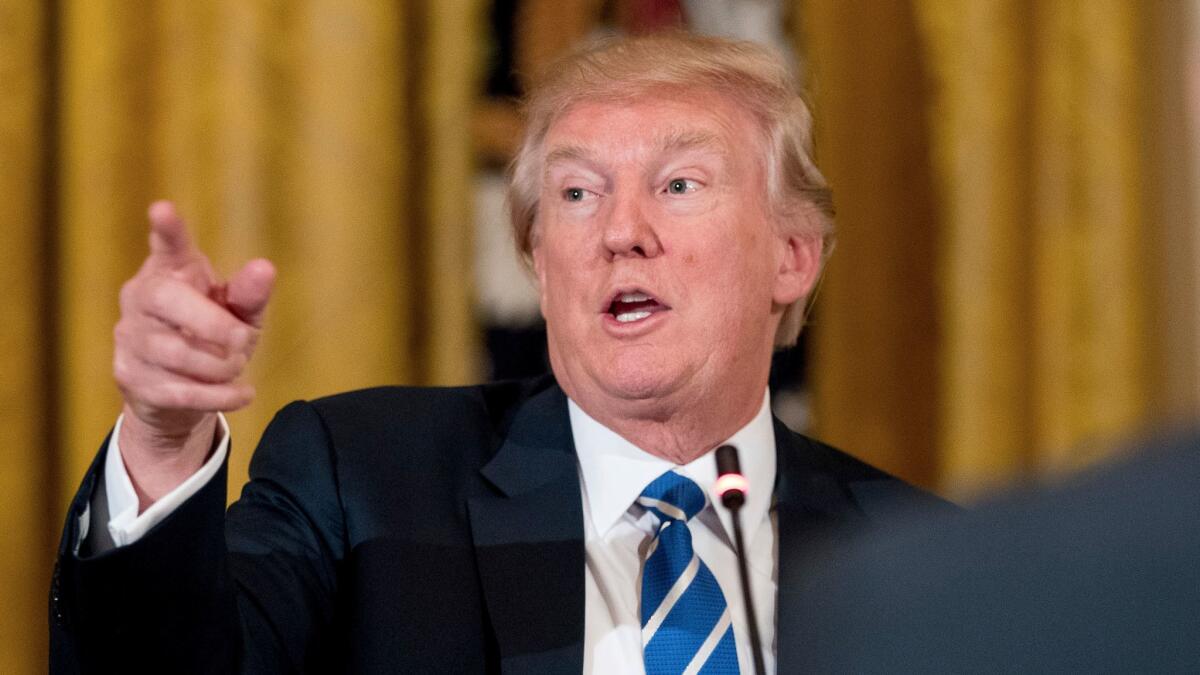Op-Ed: Trumpcare: Is this what populism looks like?

- Share via
The battle in Congress over how to replace former President Obama’s healthcare law is about much more than health insurance. It’s the first legislative skirmish in a larger struggle over what Trumpism, Donald Trump’s presidential agenda, will turn out to be in practice.
Can Trump succeed in remaking the Republican Party in his populist image? Or will the more traditional conservatives who lead the GOP majority in Congress domesticate the president and limit his agenda to the parts they like?
Trump ran for the White House with an ambitious list of promises that helped attract millions of middle-income voters who once supported Democrats.
He pledged to boost economic growth with tax cuts and deregulation; revive manufacturing jobs with new trade restrictions; end illegal immigration; replace Obamacare with something better and cheaper; and do it all without cutting Social Security, Medicare or Medicaid.
Some of those goals were shared by traditional conservatives, especially tax cuts and deregulation. Others were not; House Speaker Paul Ryan and most of his members have long maintained that balancing the federal budget requires reining in spending on Social Security and Medicare.
Trump has long boasted of his prowess as a negotiator, but he’s never negotiated with House Republicans before.
Trump doesn’t owe his election to the party establishment in Congress. He ran against it, and sometimes described Ryan as part of the problem. But the healthcare bill Ryan introduced last week does not reflect that reality.
Based on the repeal-and-replace bill Ryan drew up last year, before Trump was elected,the proposed legislation is not at all populist. It includes a big tax cut for wealthy investors. It breaks several promises Trump made in the campaign, including pledges not to touch Medicaid and to expand treatment for opioid addiction. It will reduce subsidies for older low-income workers, many of whom were Trump voters.
If Trump really wanted to turn the GOP into a “workers’ party,” as he’s claimed, this might be an obvious place to start. Instead, eager to replace Obamacare at any cost, the president endorsed the bill and even began lobbying for it.
That’s one signal that GOP legislation under Trump won’t always reflect Trumpist-populist rhetoric.
Here’s another: It’s fiscal conservatives, not moderates, who are most vocally opposed to Ryan’s plan. Members of the House Freedom Caucus, heirs of the tea party, think the bill is too expensive — too populist, in a sense. They want to speed up the process of cutting back federal subsidies for state-run Medicaid programs. Trump said he’s willing to negotiate with the holdouts, potentially moving the bill even further from his initial promises.
Trump has long boasted of his prowess as a negotiator, but he’s never negotiated with House Republicans before. If the Ryan bill gets stuck, Trump’s image as a Man of Action will take a hit. If it passes, he may still look like a Man of Action, but certainly not like a Man of the People.
And this is only the first legislative battle of many.
Trump’s populism will face a similar test when he seeks a tax reform bill, the centerpiece of his economic agenda.
His treasury secretary, Steven Mnuchin, has suggested a big tax cut for the middle class, with no net tax cut for the wealthy.
But that’s not what most Republicans in Congress have in mind. Their draft tax bills include big cuts for the well-off, and much smaller cuts for low- and middle-income earners.
We’ll see the same dynamic again when Trump produces his infrastructure plan, now postponed until next year. Stephen K. Bannon, the White House aide who has championed infrastructure spending as a way to create jobs for construction workers, has suggested a $1-trillion bill including hundreds of millions of dollars from the federal coffers. Fiscal conservatives in Congress, however, would like to minimize those figures and focus the plan on tax incentives, not spending.
In each case, will Trump insist on getting his way, or settle for what the Ryan-led Congress gives him, as he’s done with the Obamacare replacement?
Trump told his working-class voters that he’d give them a new form of Republicanism — an activist government that would deliver on manufacturing jobs, infrastructure projects and better health insurance.
He can keep some of his promises without Congress, through executive action. But much of his agenda will need legislation to become real. So far, the GOP in Congress isn’t falling in line; and Trump isn’t cracking the whip. If that’s the pattern for the next four years, Trumpism may not look much different from traditional conservatism — except for the tweets.
Twitter: @DoyleMcManus
Follow the Opinion section on Twitter @latimesopinion or Facebook
MORE FROM OPINION
Why is the federal government trading away public land to the 1 percent?
What is the government’s word worth?
Bannon and Trump leave the State Department stranded on the sidelines
President Trump is lucky to be riding a better economic wave than his predecessors caught
More to Read
A cure for the common opinion
Get thought-provoking perspectives with our weekly newsletter.
You may occasionally receive promotional content from the Los Angeles Times.











